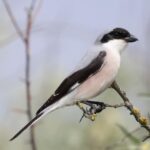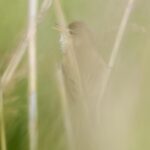A half term weekday tour today, the plan was to look for owls and try to spend some time with general birding up on the coast.
We started with a drive around some likely grazing marshes, where Barn Owls like to hunt. It didn’t take long to find out first Barn Owl of the day, perched on a post on the edge of a field. We found a convenient place to park and walked back to a gate from where we could get the scopes on it.
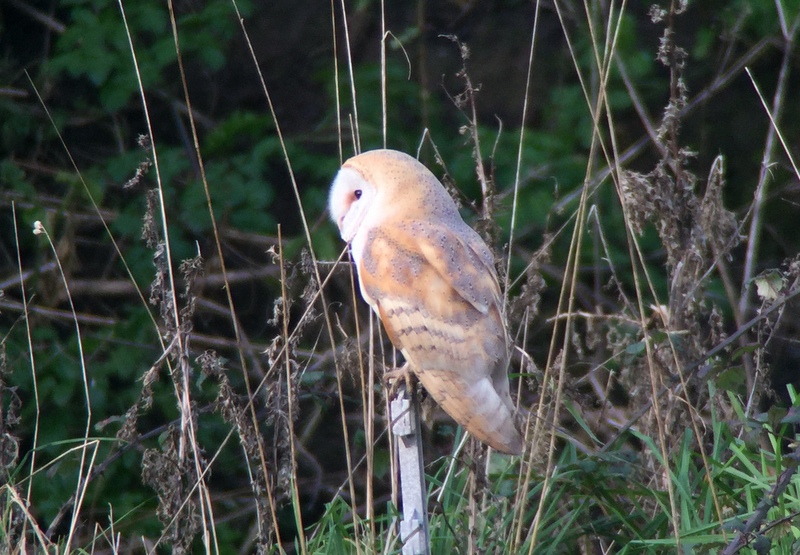 Barn Owl – our first of the day
Barn Owl – our first of the day
The Barn Owl remained on its post for a while, looking round, enjoying the morning sunshine. Then it was off again to resume hunting. It made its way along the hedge and away through the trees. There were a few other birds in the hedgerows where we had stopped. A Song Thrush was singing – they are in full voice now. A Marsh Tit worked its way along the bushes, alternately singing and calling. hopping up onto the top in front of us briefly. A Treecreeper was working its way through the trees and appeared for a few seconds to work its way up one on the edge where we could see it.
We drove on a little further and parked up again. There was no sign at first of any of the local Barn Owls on their favourite posts. So we set off to walk along the footpath beside the meadows to see if we could find one of them further along. We hadn’t got very far when one of the group spotted through the trees that a Barn Owl had now appeared on one of the posts, so we made our way back there.
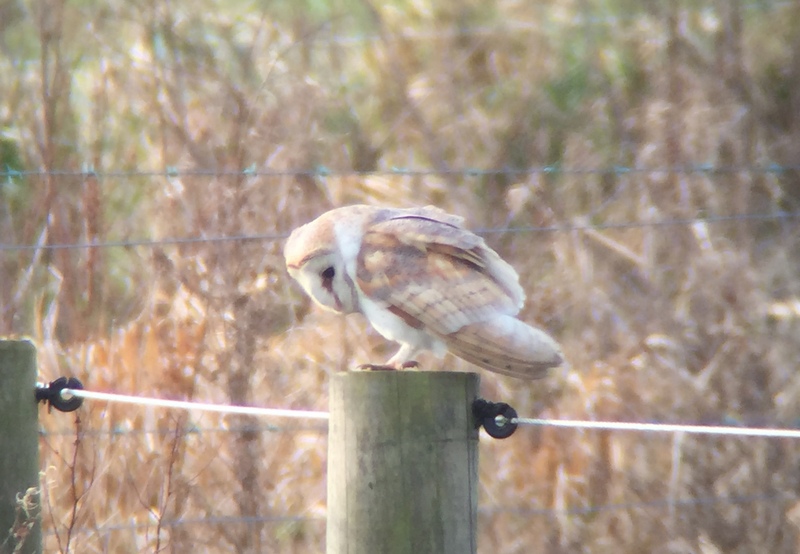 Barn Owl – hunting from the posts
Barn Owl – hunting from the posts
This Barn Owl seemed to be hunting from the fence posts. It spent some minutes perched on a post, staring down into the grass below, looking round. Then it would fly a short distance and land on another post and resume its search of the ground. It did this repeatedly, dropping down into the grass a couple of times but only hovering briefly over it once.
There were a few other birds here too. A Grey Wagtail dropped in by the water briefly, before flying off through the trees calling. Several Siskins were whizzing around through the alders. A Great Spotted Woodpecker was drumming nearby. In the end, we had to tear ourselves away from the Barn Owl and move on.
Our next target was Little Owl. We drove up to one of their regular haunts, a series of old farm buildings. They normally like to perch up on the roofs here, but we couldn’t see one in any of the usual places today. It was a nice bright morning and they normally like to sit out in the sunshine, but there was a cold southerly wind blowing which might have taken the edge off it. They had presumably found somewhere more sheltered.
A Barn Owl was a nice distraction. It flew through the trees the other side of the road and as we were standing quietly next to the car, it didn’t see us until the last minute. It appeared out of the trees directly across the road from us, flew straight towards us at first then turned and flew right past us. Stunning!
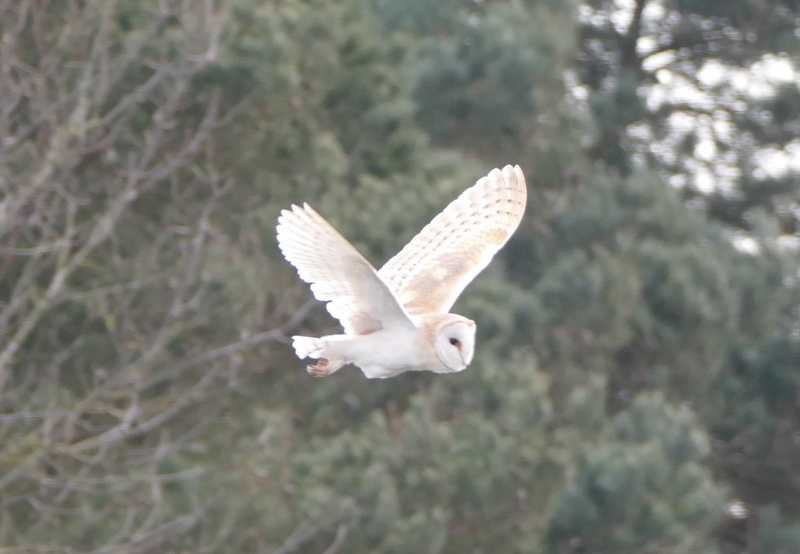 Barn Owl – flew past us while looking for Little Owls
Barn Owl – flew past us while looking for Little Owls
There were several Brown Hares running around on the grassy verges by the farm buildings. A small group of Lapwing were in the winter wheat field across the road and, later, were joined by a few Golden Plover as well. Several ragged groups of Brent Geese flew up from the coast and inland to find somewhere to feed, passing overhead. One of them looked at the winter wheat field opposite us as well, circled over it a couple of times, but seemed to be put off by us standing there and continued on inland.
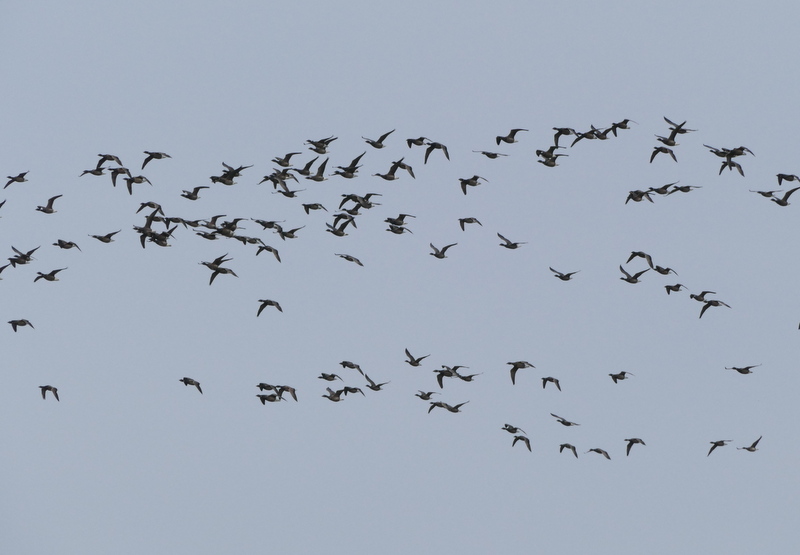 Brent Geese – flocks were flying inland to feed this morning
Brent Geese – flocks were flying inland to feed this morning
While we were standing there, we heard a Little Owl calling through the trees beside us, a little like a plaintive cat miaowing. We decided to set off to see if we could find it. We walked a little way back along the road to another gateway from where we could get a different view over the buildings. These were a little more sheltered from the wind and, sure enough, there was a Little Owl perched on a wall in the sunshine. We got it in the scope and had great views of it.
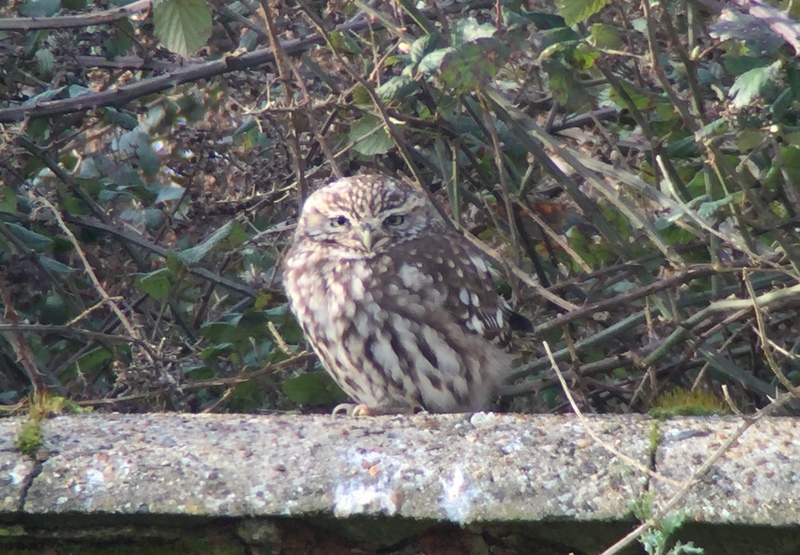 Little Owl – in a sheltered spot, enjoying the morning sunshine
Little Owl – in a sheltered spot, enjoying the morning sunshine
What was presumably the same Barn Owl was doing another circuit of the fields the other side of the road, and came straight past us again, landing in the back of the trees briefly before resuming its hunting duties.
 Barn Owl – still flying round through the trees
Barn Owl – still flying round through the trees
Out in the long grass, a large flock of Fieldfares was feeding. We could just see their heads poking out until they moved. A Song Thrush was out there too. A Kestrel perched obligingly on the overhead wires nearby and we couldn’t resist a closer look at it.
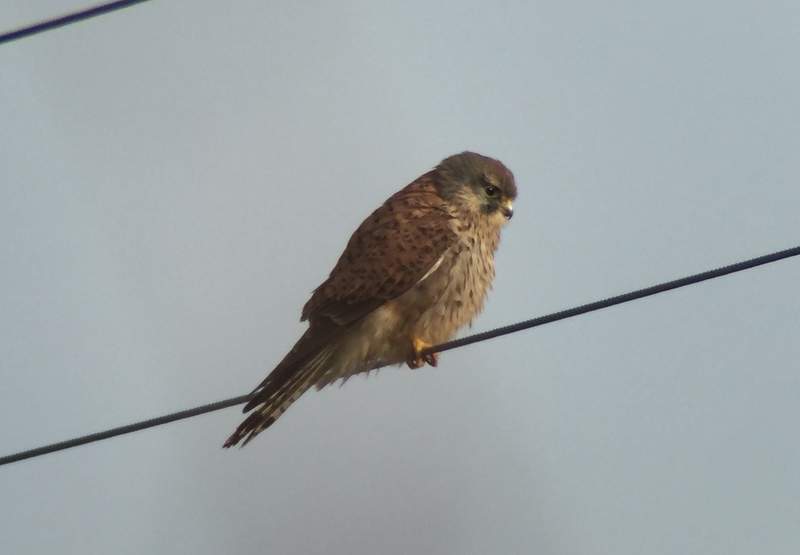 Kestrel – perched on some wires close to us
Kestrel – perched on some wires close to us
We had enjoyed a very good morning’s owling, but time was now getting on. After such success, it seemed like a good moment to switch our attention to some more general birding and return to owls later on. We made our way down to the coast and headed west.
Our next stop was at Brancaster Staithe. There are usually lots of waders around the car park here and so it proved again today. With questions over how to separate Black-tailed and Bar-tailed Godwits, this was a good opportunity to get up close with some of the latter. There were several Bar-tailed Godwits feeding around the edge of the harbour channel and we studied them in the scopes – their well-marked, pale buffy coloured upperparts, and striking pale supercilium, complementing the slightly upturned bill and shortish legs.
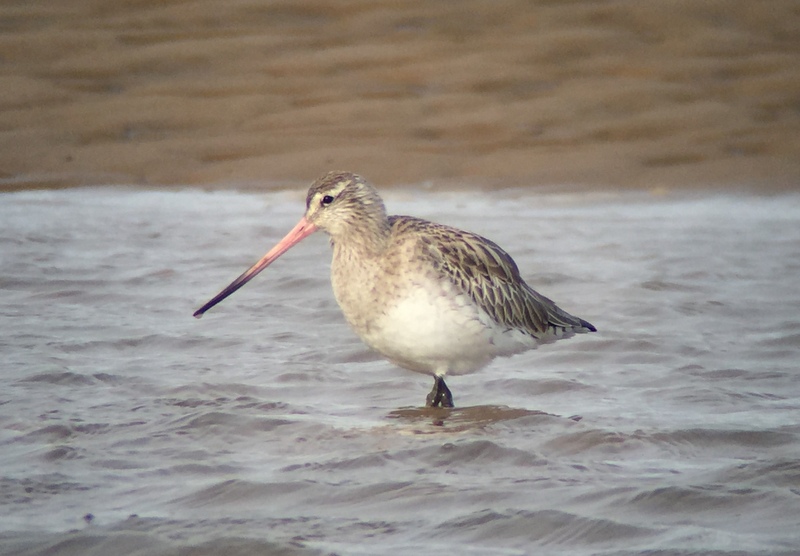 Bar-tailed Godwits – a good opportunity to look at them close-up
Bar-tailed Godwits – a good opportunity to look at them close-up
There were lots of Turnstones picking around in the car park and Oystercatchers too, particularly where the local mussels had been brought ashore to be washed and sorted, leaving lots of pickings for the birds. A couple of Grey Plover were unobtrusive out on the mud. A little group of diminutive Dunlin was feeding down at the water’s edge. A much larger Curlew was on the sandbank opposite.
We had also come to look for the Red-necked Grebe which has been here on and off for several months now. It is not always around, but thankfully it didn’t take too long for us to locate it today. It was swimming around among the boats, further up the harbour channel. We got it in the scopes where we could see it, diving regularly.
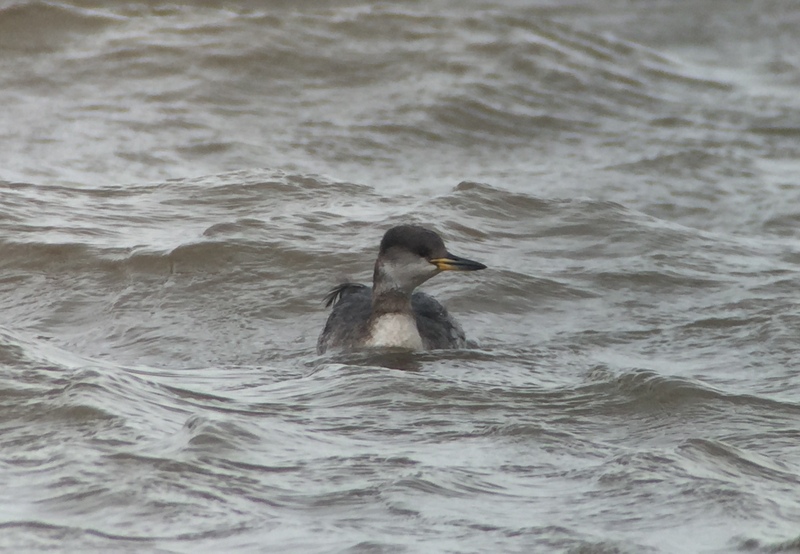 Red-necked Grebe – a recent photo, when it was closer in
Red-necked Grebe – a recent photo, when it was closer in
We had a drive inland next to see if we could find one of the Rough-legged Buzzards. They seem to have been seen at Choseley less regularly in recent days, so we had a quick look round some of their other favourite sites, but we couldn’t find one today. A Barn Owl flying right across the road just in front of the car on a quiet back road was a nice compensation for our efforts, and still out hunting in the middle of the day too.
We had a quick drive round at Choseley just in case, but there was no sign there either today. A couple of Common Buzzards were enjoying the breeze, hanging in the air over one of the pine copses on the ridge. Then we dropped down to Titchwell for lunch.
The feeders by the visitor centre were full of finches, as usual – Chaffinches, Greenfinches and Goldfinches. A Marsh Tit zipped in and out briefly and the Long-tailed Tits were enjoying the peanuts. Round at the back, there were several Bramblings in with the throng as usual. The two males were subtly different – one with a much blacker head already, the other still with considerably more pale fringing to the head and back feathers, yet to wear off to reveal the black summer plumage. A single female Brambling dropped in as well, but was chased off her perch at the feeders by one of the greedy males.
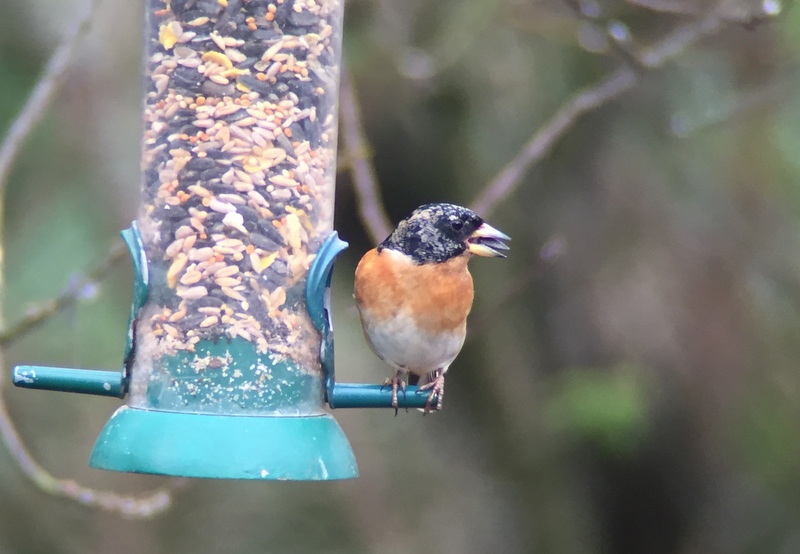 Brambling – this male was blacker-headed already than the other
Brambling – this male was blacker-headed already than the other
Despite lots of visitors today and lots of noise (it is half term!), the Water Rail was down in the ditch by the main path as usual. A lot of people simply walked past it, but equally it seemed to largely ignore us staring down at it, cameras clicking. It was well hidden at first in the overhanging vegetation but gradually worked its way out into the open. Eventually something spooked it and it scuttled back quickly into cover.
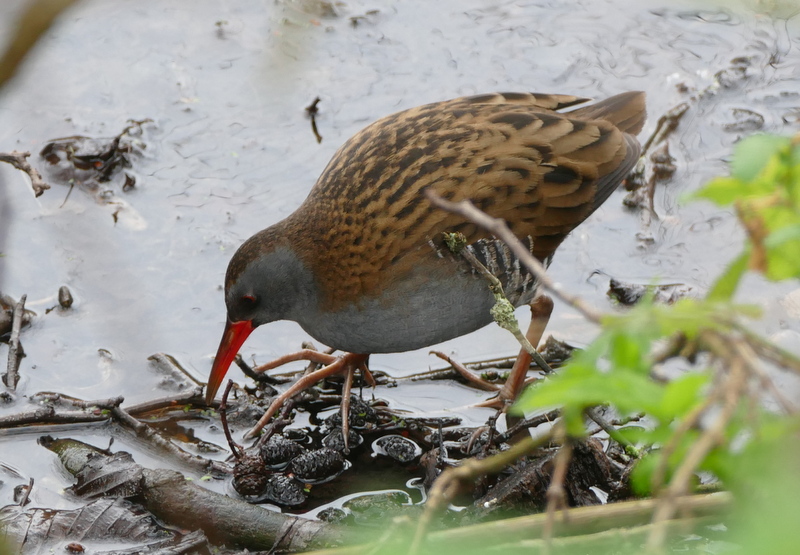 Water Rail – largely oblivious to the stream of visitors on the main path
Water Rail – largely oblivious to the stream of visitors on the main path
Further along, we stopped to scan the still dried-out grazing meadow ‘pool’. At least the pipits have been enjoying it. It didn’t take us long to find the lone Water Pipit, quite close today. We had a really good look at it in the scope, much whiter below, more neatly streaked, a more obvious pale supercilium and a cleaner grey-brown above, compared to the two rather swarthy Rock Pipits nearby. A Barn Owl, our first of the afternoon, was circling over the marshes at the back, towards Thornham. A raft of Common Pochard was on the reedbed pool, along with 2-3 Tufted Ducks.
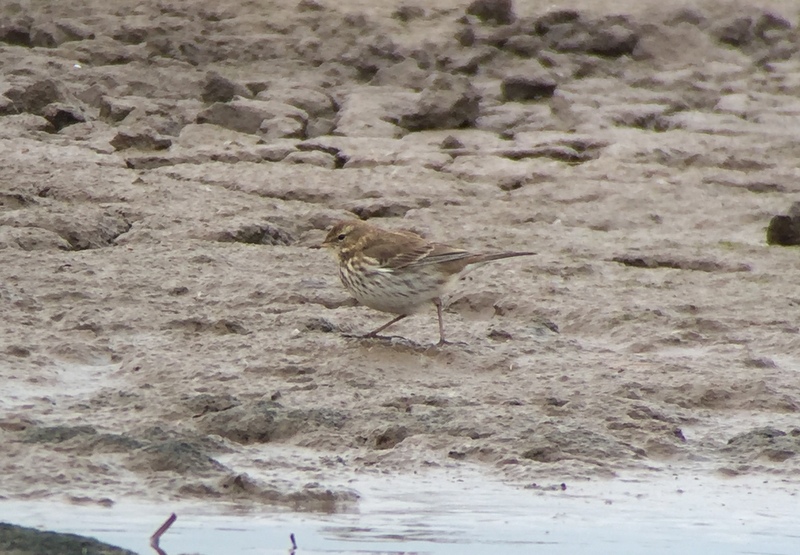 Water Pipit – on the drained grazing meadow ‘pool’ again
Water Pipit – on the drained grazing meadow ‘pool’ again
Having been lowered right down for management work to be undertaken, there is a little more water again on the freshmarsh at the moment. The waders were certainly making the most of it. There were 42 Avocets on there today – a winter site record, according to the warden! Several large groups of Dunlin were feeding feverishly on the exposed mud. And there were good numbers of Black-tailed Godwits on here today, with several right down in front of Island Hide. We had a good look at them, remembering the Bar-tailed Godwits we had seen earlier and noting the differences.
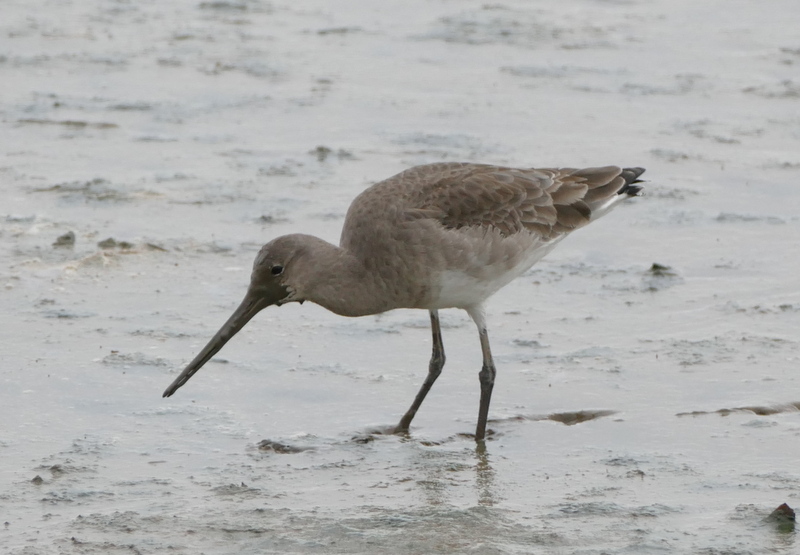 Black-tailed Godwit – enjoying the wet mud on the freshmarsh
Black-tailed Godwit – enjoying the wet mud on the freshmarsh
It had been a lovely bright morning, but high cloud was now starting to encroach from the west. We made our way out towards the beach, just in case the forecast of rain this afternoon proved to be correct (it didn’t!). We stopped again at the Volunteer Marsh to look through the waders. As well as lots of Redshank and a few Curlew, we found a couple of rather unobtrusive Knot, picking around one of the island of vegetation on the edge of the mud. Closer to the path, we got a smart Grey Plover, resplendent even in its winter plumage, in the scopes.
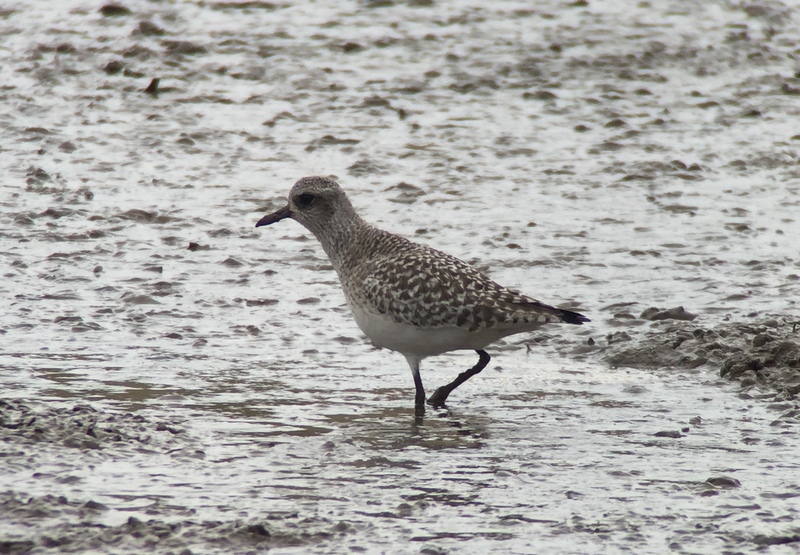 Grey Plover – in white-spangled grey winter plumage
Grey Plover – in white-spangled grey winter plumage
A lone Ringed Plover on the edge of the mud was soon joined by a load more, presumably flying in from the beach. One of them, a brighter bird, was noticeably aggressive to some of the others, chasing after them and calling.
 Ringed Plover – a small group flew in to the Volunteer Marsh
Ringed Plover – a small group flew in to the Volunteer Marsh
We heard a Spotted Redshank call further over and made our way along to look for it, but there was no sign along the channel at the far end. There were lots of Black-tailed Godwits there and a single Bar-tailed Godwit – an opportunity to see both species close to each other. An Avocet was feeding in the deep channel by the path, sweeping its bill from side to side. There was no sign of the Spotted Redshank on the other side of the bank either, on the Tidal Pools. In fact, there were rather few waders on there today, just a few more Bar-tailed Godwits.
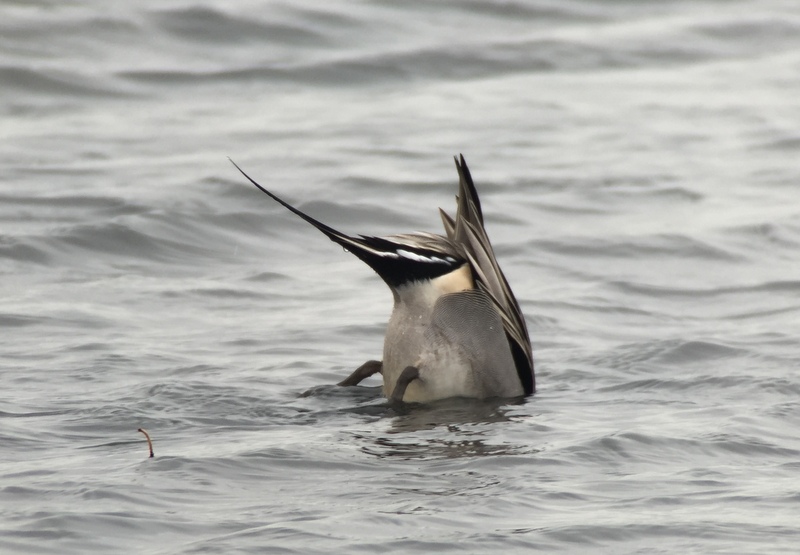 Pintail – you can see where it got its name when the drakes are feeding!
Pintail – you can see where it got its name when the drakes are feeding!
There were a few more ducks on here today. We spent some time admiring all the Pintail, many of them now organised into pairs. The drakes are looking very smart at the moment. We got one of them in the scope and had a good look at it. They were upending in the shallow water to feed, giving us a great view of their pin-shaped central tail feathers as they did so.
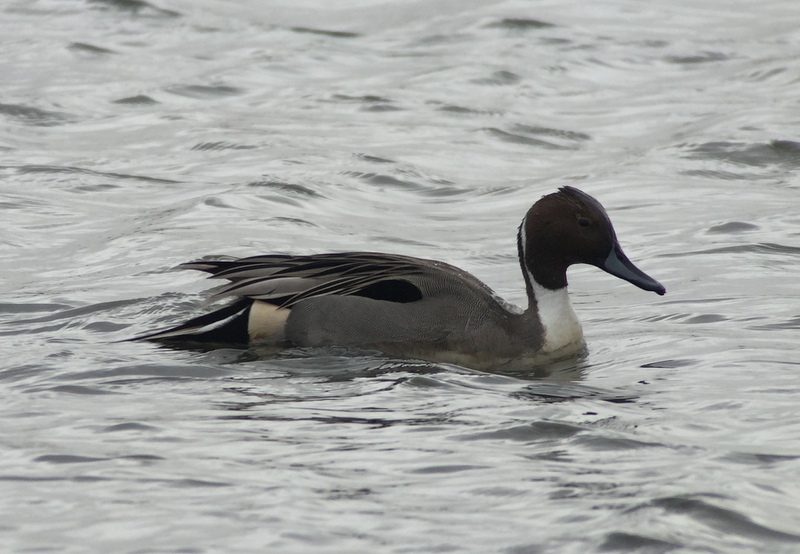 Pintail – a more conventional view of a smart drake
Pintail – a more conventional view of a smart drake
While we were scanning through the ducks, our attention was drawn to a dark duck on the mud at the back. It looked distinctly out of place – it appeared to be limping, as it walked across to the water and started to swim. It was a Common Scoter, a young male, rather blotchy in appearance as it starts to gain some more of its black adult feathers. There are lots of them on the sea through the winter here, but you rarely see one come in onto the pools. A female Goldeneye was also diving out here.
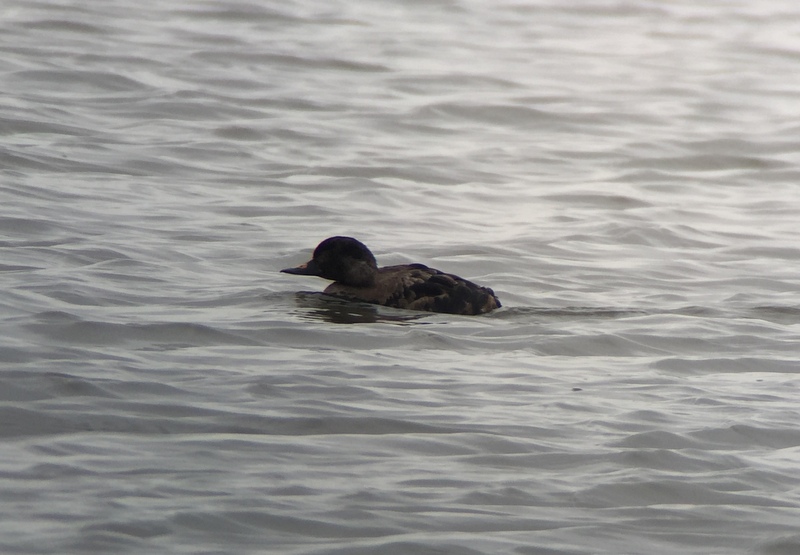 Common Scoter – a young drake was on the tidal pools briefly
Common Scoter – a young drake was on the tidal pools briefly
Out on the beach, the tide was high. There were still lots of waders along the tideline – Oystercatchers and Bar-tailed Godwits, and a few Sanderling in with the larger flocks of Dunlin.
We had a look out to sea, which was fairly calm today, now that the wind had dropped. A pair of Red-breasted Merganser were fairly close inshore, and we managed to get a good look at them when they stopped diving long enough. There were more Goldeneye out on the water. The small raft of Common Scoter were quiet a long way out today and we couldn’t see anything else in with them. While we were standing there, the Common Scoter we had seen earlier flew back out from the Tidal Pools over the beach to the sea – normal service resumed!
We made our way back along the main path, and stopped to scan the waders along the channel on the Volunteer Marsh again. This time we found the Spotted Redshank. It was towards the back, but we got it in the scope so everyone could see it. There was a Redshank next to it at one point and you could see the paler, silvery grey colour of the Spotted Redshank and its longer, finer bill.
While we were watching the Spotted Redshank, we had a call from the warden (thanks!) who was standing a little further along – a young Peregrine was making a pass over the freshmarsh and had scattered all the waders. We could see it circling up over the roof of the Parrinder Hide, with flocks of Lapwing and Dunlin whirling round nervously. It climbed up and then made another pass over the mud, powering down and disappearing behind the bank, before climbing up again. It wasn’t having any luck, but was creating pandemonium among all the birds which had been on the freshmarsh!
We stopped to talk to him on our way back, and he told us that rather annoyingly a Short-eared Owl had flown across the reserve while we had been out at the beach and dropped down over the bank at the back, towards Brancaster. We had been scanning the dunes and saltmarsh on the way hoping for just such an event. We had to content ourselves with yet another Barn Owl hunting in the distance over that side.
Back at the car and we started to make our way back west. We had a drive out to the beach at Brancaster and a quick stop again at Brancaster Staithe to see if we could find the Short-eared Owl hunting out around the golf course, but all was quiet. We did find more Barn Owls on our way back – we stopped to watch three hunting over the grazing marshes by the road at Holkham. They were working their way methodically round the edges of the fields – one of them dropped sharply down into the long grass, presumably having heard something. As we drove further along, another flew over the road in front of us and one was hunting along some rough grass beside the road, taking us to a grand total of 11 Barn Owls for the day!
We couldn’t hang around now, as we had an important appointment with some Tawny Owls. They were hooting already when we arrived, before we got into position, which made it hard to judge exactly where they were roosting today. By the time we had walked down into the trees, our regular bird had either come out of the roost already or had been sleeping in a different place today.
We listened to Tawny Owls hooting on both sides of us for a while, then a large shape flew silently through the trees in front of us. It landed above the path briefly, but only one of the group got onto it before it flew again further along. We made our way quickly back and could hear it hooting. This time, we could see where the Tawny Owl had landed and got the scope onto it, where everyone could see it. We could see it perched on a branch, in the last of the evening’s light, hooting. Then it disappeared silently back into the wood. It was a great way to end the day, and we walked back to the car with several Tawny Owls hooting all around us.
 Tawny Owl – this one taken in the same trees a few days ago
Tawny Owl – this one taken in the same trees a few days ago
It had been a great day’s birding – we had been lucky with the weather, as the forecast rain had still not arrived. Only as we drove back to the meeting point, did it start to spit and on the way home the rain finally arrived. Perfect timing!
